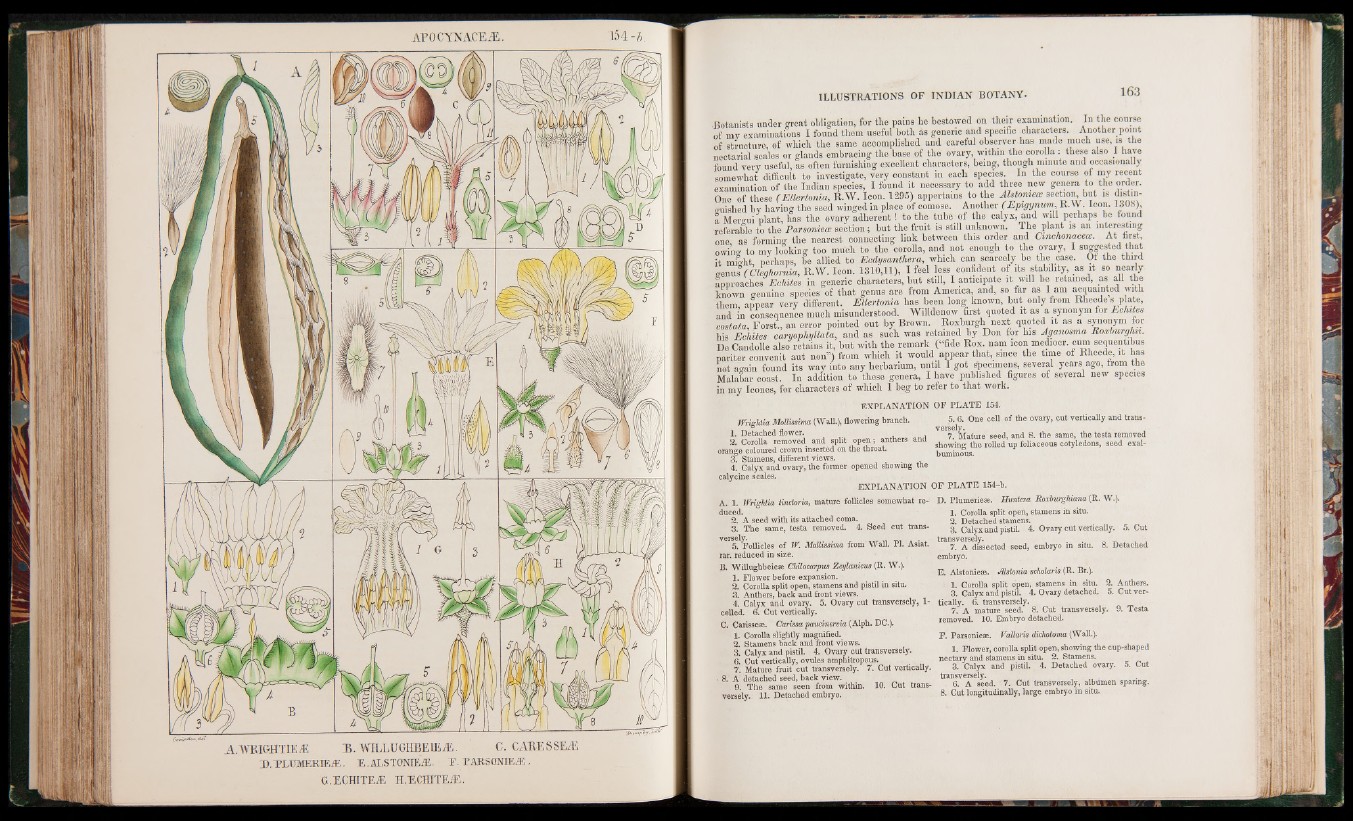
A P O C Y N A C E Æ . 154 -b.
A . 'W P v I G H T D E Æ B . W I L L U G H B E 1 B Æ . C . C A R E S S E Æ
ID.TLUMERIEÆ. E.ALSTONIEÆ. T.ÏARSONXEÆ.
G . E C H I T E Æ H . E C H I T E Æ .
Botanists under great obligation, for the pains he bestowed on their examination. In the course
of my examinations I found them useful both as generic and specific characters. Another point
of structure of which the same accomplished and careful observer has made much use, is the
nectarial scales or glands embracing the base of the ovary, within the corolla : these also I have
found very useful, as often furnishing excellent characters, being, though minute and occasionally
somewhat difficult to investigate, very constant in each species. In the course of my recent
examination of the Indian species, I found it necessary to add three new genera to the order.
One of these ( Ellertonia, R.W. Icon. 1295) appertains to the Alstomeos secUon, but is distin-
auished by having the seed winged in place of comose. Another (Epigynum, R.W. Icon. $308),
a Merffui plant, has the ovary adherent! to the tube of the calyx, and will perhaps be found
referable to the Parsoniece section; but the fruit is still unknown. The plant is an interesting
one as forming the nearest connecting link between this order and Cmchonacew. At first,
owing to my looking too much to the corolla, and not enough to the ovary, I suggested that
it might, perhaps, be allied to Ecdysanthera, which can scarcely be the case. Of the third
genus ( Cleahornia, R.W. Icon. 1310,11), I feel less confident of its stability, as it so nearly
approaches' Echites in generic characters, but still, I anticipate it will be retained, as all the
known genuine species of that genus are from America, and, so far as I am acquainted with
them appear very different. Ellertonia has been long known, but only from Rheedes plate,
and in consequence much misunderstood. Willdenow first quoted it as a synonym for Echites
costata, Forst., an error pointed out by Brown. Roxburgh next quoted it as a synonym for
his Echites caryophyllata, and as such was retained by Don for his Jganosma Roxburgka.
De Candolle also retains it, but with the remark (“fide Rox. nam icon mediocr. cum sequentibus
pariter convenit aut non”) from which it would appear that,I since the tune of Rheede, it has
not again found its way into any herbarium, until I got specimens, several years ago, from the
Malabar coast. In addition to these genera, I have published figures of several new species
in my leones, for characters of which I beg to refer to that work.
WrigUia Mollmirm (Wall.), flowering branch.
1. Detached flower.
2. Corolla removed and split open; anthers and
orange coloured crown inserted on the throat.
3. Stamens, different views.
4. Calyx and ovary, the former opened showing the
calycine scales.
EXPLANATION
A. 1. WrigUia tindoria, mature follicles somewhat reduced.
2. A seed with its attached coma.
3. The same, testa removed. 4. Seed cut transvers^
ely-Qiiicieg of ^ froih Wall. PI. Asiat.
rar. reduced in size.
B. Willughbeieae Chilocarpus Zeylanicus (R. W.).
1. Flower before expansion.
2. Corolla split open, stamens and pistil in situ.
3. Anthers, back and front views.
4. Calyx and ovary. 5. Ovary cut transversely, 1-
celled. 6. Cut vertically.
C. Carisseae. Carissa paudnervia (Alph. DC.).
1. Corolla slightly magnified.
2. Stamens back and front views.
3. Calyx and pistil. 4. Ovary cut transversely.
6. Cut vertically, ovules amphitropous.
7. Mature fruit cut transversely. 7. Cut vertically.
- 8. A detached seed, back view.
9. The same seen from within. 10. Cut transversely.
11. Detached embryo.
EXPLANATION OF PLATE 154.
5. 6. One cell of the ovary, cut vertically and transversely.
7. Mature seed, and 8. the same, the testa removed
showing the rolled up foliaceous cotyledons, seed exal-
buminous.
OF PLATE 154-b.
D. Plumerieas. Huntera Roxburghiana (R. W.).
1. Corolla split open, stamens in situ.
2. Detached stamens.
3. Calyx and pistil. 4. Ovary cut vertically. 5. Cut
transversely. . .
7. A dissected seed, embryo m situ. 8. Detached
embryo.
E. Alstonieae. •Mstonia scholaris (R. Br.).
1. Corolla split open, stamens in situ. 2. Anthers.
3. Calyx and pistil. 4. Ovary detached. 5. Cut vertically.
6. transversely.
7. A mature seed. 8. Cut transversely. 9. Testa
removed. 10. Embryo detached.
F. Parsonie*. Vallaris dichotoma (Wall.).
1. Flower, corolla split open, showing the cup-shaped
nectary and stamens in situ. 2. Stamens.
3. Calyx and pistil. 4. Detached ovary. 5. Cut
transversely.
6. A seed. 7. Cut transversely, albumen sparing.
8. Cut longitudinally, large embryo in situ.